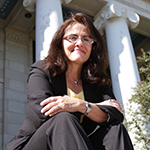Some of the most humbling words Jose Marquez-Leon has ever heard were spoken by an eight-year-old boy. He met the child in 2007, on a humanitarian trip that Latinos in Information Sciences and Technology Association (LISTA) made to the Dominican Republic. In Cabarete, a community less than five miles wide set along the country’s northern coast, Marquez-Leon surveyed the progress of a technology training center LISTA had built and wired with secondhand computers from the United States. The boy’s testimonial provided more evidence than any count of bricks laid or child-to-computer ratio ever could.
“I’d like to go to Paris one day,” the boy told Marquez-Leon, “because I’d like to be an architect. I spent hours after school”—where once there was no school—“looking at pictures of Paris on the computers, and I want to build cities like Paris.”
Seven years later, Marquez-Leon still gets choked up telling that story. It is one of the purest examples of LISTA’s mission at work: to support Latinos in the science, technology, engineering, and math (STEM) fields through education, networking, and, as in the Dominican Republic, physical technological resources.
“In the Dominican Republic, we have seen firsthand what technology can do to change a community when it comes into a neighborhood for the first time,” Marquez-Leon says. “Where there were dirt roads and shacks, within five years you see roads becoming paved, businesses being built, and kids going to high school at 1:00 p.m. instead of out to the field to cut sugar cane.”
Marquez-Leon is a telecom veteran, joking that in 1997, he and his cofounders were “talking about STEM before it was cool,” at a time when he says placing the words “Latino” and “technology” next to each other was an oxymoron. LISTA was born out of just such discussions. While he was working for Mi8 Corporation, Marquez-Leon was invited to a United Nations event to discuss the topic of broadband Internet connectivity in Africa. With the ears of the world’s ambassadors at his disposal, he couldn’t pass up the opportunity to speak his mind. “I got up and just said, ‘Why are we worrying about going to Africa when we have so many places, like the South Bronx, that don’t have connectivity?’” Marquez-Leon says. As an implementation engineer, he knew the infrastructure and where its holes left Latinos off the grid—“a technological social injustice,” as he puts it. “LISTA basically built itself that day.”
Since then, the organization has grown from six STEM professionals bemoaning the lack of Latinos in their field to 14 chapters across the United States, each with thousands of members. First, they introduced Hispanic chambers of commerce, businesses, and schools to e-mail, data collection, and electronic newsletters, giving those institutions something they never had before: an invitation to join the 21st century and play in the same arena as their mainstream counterparts. Next, they needed to sustain what they started. To do that, they needed to educate the next generation.
When he was in high school, Marquez-Leon sardonically says that he had the great opportunity to have a counselor who told him—despite his achievements in math and science—that he only had two options after graduation: the military or “McDonald’s hamburger university.” However, he had a mother who wouldn’t take things lying down, so he chose to pursue his academic strengths.
LISTA
By the Numbers
4,700+
Professional members in LISTA
16%
Percentage of Hispanic students who began college in 2004 as STEM majors and completed a STEM degree by 2009, compared to 25 percent of white students
68%
Percentage of Hispanic secondary-education students who attend a community college, thereby decreasing their odds
of majoring in STEM
Latino students are facing the same obstacles to higher education in American schools today, and that lack of encouragement is one front on which LISTA is fighting the gaping disparity between the Hispanic student population and the number of Hispanic STEM field graduates. “The most important piece of the puzzle is creating awareness, that STEM is the future of our country, and we must be an active player in it,” Marquez-Leon says. “We need to show [Hispanic] students that we are a part of this industry. In their minds, they feel only others, not Latinos, can pursue STEM jobs, because they don’t see enough of us. If they never see us, they’ll never be us.”
While some of their contemporaries have taken a political approach to the problem of underserved Latino students, LISTA’s members have used their own talents to address the issue, with the goal of any initiative, from technology centers to emerging technology summits, to empower Latinos by putting technology in their hands. “That’s what technology does,” he explains. “It eliminates poverty because it changes your mind-set.”
Marquez-Leon says LISTA has also been instrumental in preserving the STEM assets the Hispanic community does have. With electronic records becoming more regulated in the medical field, LISTA has facilitated Latino doctors in staying compliant. “We have an epidemic of few doctors that serve our community, and we don’t want to lose any more,” Marquez-Leon says. “Not complying is not an option. Latino primary-care physicians must adopt electronic health records. They must be made aware of the consequences.”
For Marquez-Leon personally, LISTA has given him the opportunity to affect the lives of many individuals whose stories, like the boy from Cabarete, reinforce the work still to be done and remind everyone of the life-changing benefit of the organization. “LISTA has been helping in the background for many years now,” Marquez-Leon says. “It has helped a lot of organizations go from zero to hero and helped leaders go from schoolrooms to boardrooms. Our biggest goal now is to make sure more Latinos and Latinas are a part of the dialogue on technology and building tech businesses of their own.”

